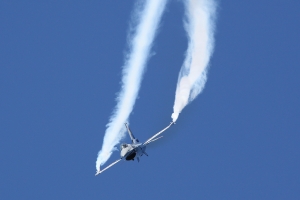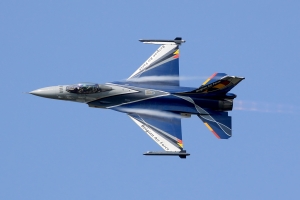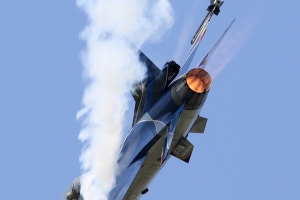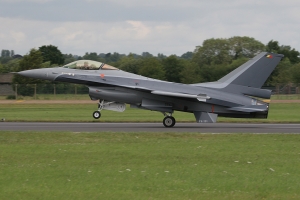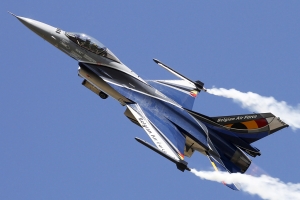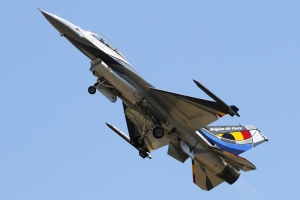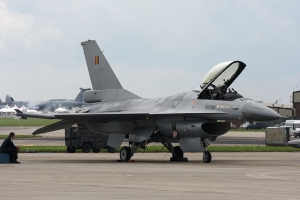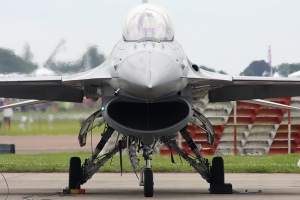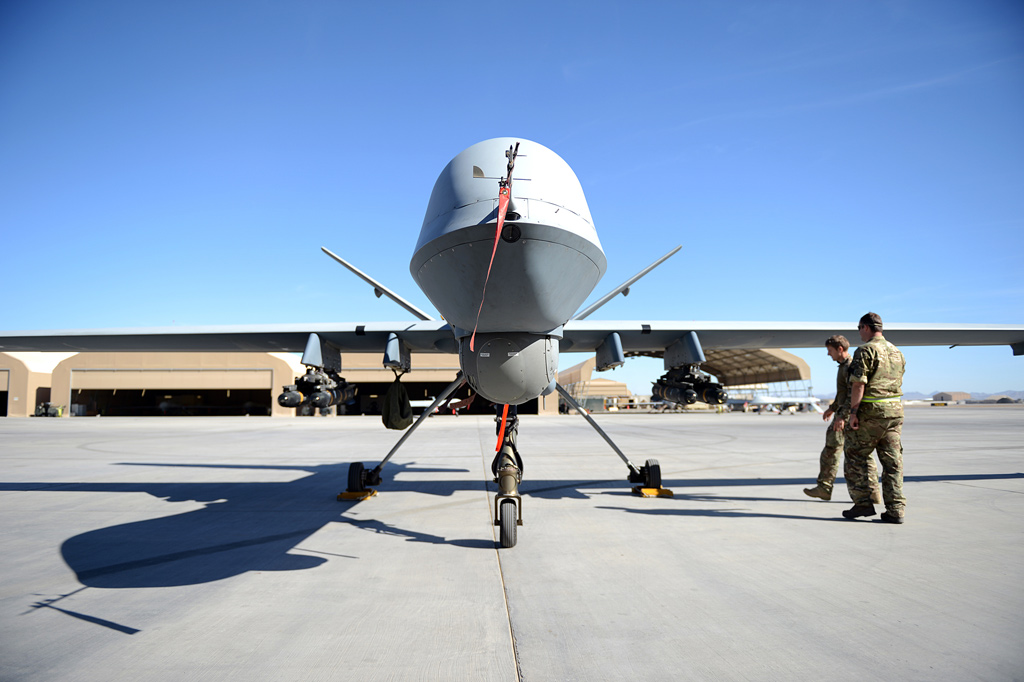A regular visitor to the UK’s airshows since the 1980s, the Belgian Air Force (often referred to as the Belgian Air Component) F-16 demo remains a crowd favourite to this day. Gareth Stringer sat down with demo pilot Capt Renaud “Grat” Thys to talk about displaying the Viper.
I’m at RNAS Yeovilton and it’s the middle weekend in a three-week run that will see the UK basking in scorching weather at RAF Waddington and RIAT, with Air Day and Flying Legends at Duxford in between. I’ll learn later that this was the hottest day of the year so far, but for now I am standing with Renaud Thys and we are waiting for the Royal Navy’s Commando Assault to finish so that we can sit down and talk in peace and quiet!
Captain Avi Renaud “Grat” Thys is from 350 Squadron based at Florennes Air Base and is the Belgian Air Force’s Lockheed Martin F-16AM solo display pilot, flying his specially-decorated F-16AM, coded FA-84. Aged 29, Grat obtained his wings as a military pilot in 2004 and now has more than 2,000 flying hours, 1,500 of them on the F-16AM.

© Shaun Schofield – www.globalaviationresource.com
Grat is shaking his head and laughing as the set-piece’s pyrotechnics continue to go off – still impressed by the lengths to which we sometimes go at UK shows, despite this being his second year displaying the F-16 Fighting Falcon.
He’s also in the middle of a busy run, for not only did he display at Waddington last weekend but he’d already displayed in France earlier today, before flying to Yeovilton for his slot this afternoon, and will of course be back the following weekend at RIAT. It’s a hectic time although, as Grat explains, it does feel a little different having got that first year under your belt.
“The thing with year one is that all you can only think about is, ‘Do not break any rules, do not bust any lines and do not fly over the crowd!’ It’s actually quite stressful because you don’t know airshows very well so you have to get used to that and the organisation around them.

© Shaun Schofield – www.globalaviationresource.com
“I had to work a lot harder last year, and the change now is that I know that I am okay with the rules so I can focus on my display sequence a lot more.”
In this regard, Grat is no different from Flt Lt Jamie Norris, Captain Stefan Hutten or Capitaine Benoit Planche, or indeed any military fast jet display pilot – performing low-level aerobatics in a high performance aircraft remains a ‘big deal’ and one which demands great respect.
“It’s not easy and it is very different from anything else that we do. The thing with the solo display (in Belgium) is that you do it for three years and then it is someone else’s turn, but we don’t really have the mentoring and coaching system like they have in the Netherlands, for example.

© Glenn Beasley – www.globalaviationresource.com
“This means that you have to learn a lot of things on your own and you make your mistakes on your own, but equally, there is a lot of freedom and latitude when it comes to designing the sequence, for example, and that’s nice to have.”
We see the F-16 at airshows in the UK flying alongside the likes of Typhoon, Rafale and Gripen and you’d be hard pushed, if you didn’t know, to pick out the aircraft which will be celebrating its 40th birthday next year, which is exactly what the Fighting Falcon will be doing. The aircraft remains an incredible performer, though, not just in an airshow-sense, but in the role for which it was designed.
“It’s been a superb investment for us, in Belgium, no question. We bought it initially as a fighter, and then as a fighter / bomber when we retired our Mirage Vs, and are now going through the MLU upgrade process which means we have caught up with all the other F-16 users.

© Glenn Beasley – www.globalaviationresource.com
“We now have to think about a replacement and it is actually a very difficult question because the F-16 still does everything that we need it to. It is still evolving and we are getting roughly one upgrade every twelve months. As a combat aircraft it will go down as a classic, I agree… It’s a great machine and was very well designed right from the start. If you look at the thrust-to-weight ratio and manoeuvrability, for example, then you would never think that the aircraft is that old…”
I’m sure it doesn’t feel that old either?
“No, no, it doesn’t, and my display jet was 29 years old just last weekend! Sometimes you might look inside a panel on the aircraft and it looks like an old Soviet submarine or something in there, because it is a certain age, but we have no issues with fatigue or cracks; the F-16 is also very robust.”

© Glenn Beasley – www.globalaviationresource.com
You’d have to say that it doesn’t look old either and this year Grat’s display jet, FA-84, is in a very impressive new colour scheme.
“I wanted to make a clean break from my predecessor, not because I didn’t like him,” he laughs, “but because I think a new pilot should mean a new routine and a new scheme.
“I worked with new designers and one of them is a specialist in scale model decals and the other is actually a design professor! They knew each other already and approached me with an idea – the professor did the tail and the other guy did the rest, including all the tricky curves around the intake.

© John Higgins – www.globalaviationresource.com
“I really wanted a vintage look and initially was thinking about just polished metal – but the Air Force said ‘No, you can’t do that!’ I am really happy with it though and think it pops quite nicely when the light is good. “
Many people have displayed the F-16 over the years, and will no doubt continue to do so, meaning that doing anything genuinely ‘new’ with a routine is pretty much impossible to achieve. On that basis, I wonder how Grat approached the job of putting his sequence together?
“I went about it with a lot of trial and error actually! I wanted the flying display to appeal to the 95% of people who attend airshows who actually don’t really know much about aviation.

© John Higgins – www.globalaviationresource.com
“So, I picked manoeuvres that I felt would be easy for people to understand, and decided to only fly on a parallel or perpendicular track. If someone sees the aircraft flying straight past them, I think they can understand that, and while I do play with the 45° axis in my poor weather (flat) show, that really isn’t what my philosophy is all about.
“Beyond that, I wanted to demonstrate the fact that the F-16 is a big engine with wings, so not too fast throughout, but with lots of power and afterburner and a big contrast between high speed and low speed. If you fly either fast or slow for too long, people get used to it and there is no contrast.
“Finally, there was one manoeuvre that I was really keen to include, and that was a rolling tuck-under. It is a typical F-16 air combat manoeuvre which we use to try and push an opponent out in front of us. It is quite different to the rest of the display, and you lose a lot of energy, and also a lot of height, but I really wanted to integrate it.

© John Higgins – www.globalaviationresource.com
“As you say, pretty much everything has been done before, so all you can do is pick your sequence and decide how you are going to fly it. You can start at 500kts or you can start at 200kts for example… and I like to start on the slow-side of things, to stay closer.
“Also, I looked at the other main F-16 displays in Europe; the Dutch and the Turkish, and tried to make sure that mine was done differently. We are quite often at the same airshows so if people see all three displays, it is kind of stupid if they are all the same, and I think we pretty much succeeded in all doing something different.”
That much, I think, was abundantly clear at the RAF Waddington International Airshow and anyone watching all three routines closely, couldn’t have failed to see just how dissimilar they are.

© Shaun Schofield – www.globalaviationresource.com
“The Dutch is completely different to mine with a lot of G and a lot of level turns, while SoloTurk likes to go very high and I like to stay a little closer, but hopefully that makes all three of them enjoyable for the crowd too.”
Just like our own Royal Air Force solo displays, having drawn up his sequence, Grat used the simulator to check various elements before taking it airborne for the first time.
“The sim is useful for checking fuel consumption as that is really something that will drive your display. I fly 18 manoeuvres and I don’t think it will fly 19 – I am landing with diversion fuel at the end of each one. Also, the sim is great for practising emergencies and procedures which you obviously can’t, and wouldn’t want to, practise in the aircraft”

© Shaun Schofield – www.globalaviationresource.com
In terms of the sequence itself, Grat was able to use what basically amounts to the bible of Belgian F-16 displays – and it’s a book that would be fascinating to see!
“It is a big old book and it contains every single Belgian Air Force F-16 display routine since the very beginning– so that gave me some inspiration – and I was able to fly three back-seat trips with my predecessor, Cmdt Michel “Mitch” Beulen. This got me used to the manoeuvres before stepping down to 3,000’ and then I was on my own.
“The first time I flew it, the guy who was supervising said to me, ‘That was a lot of manoeuvres but I didn’t recognise any of them!’”

© John Higgins – www.globalaviationresource.com
Thankfully, after some rethinking and plenty of practice, and with Grat now well in to his second season, he feels that he is truly pushing against the limits – both his and the F-16’s.
“I don’t think that I can go much further. The Flight Control Computer is the first thing that limits you – it basically gives you +9G and -3G. We can play with that little bit as we have the old FCC, same as the Dutch, so you can actually get -3.2G, but I think all three of the F-16 displays push those limits, one way or another.
“You also have to be aware of your own body limits, and when I started displaying there would have been no way that I could have flown the way I am flying now. It was pretty much all about just surviving the display, but you start getting used to it, managing the G and the speed… It’s a big learning experience. The hardest one is after the high speed pass, and that is about 270° of sustained 9G, but the rest is maybe two / three seconds of 8G, for example, because I tend to fly a slower display.

© Shaun Schofield – www.globalaviationresource.com
“Toughest of all is the flat (poor weather) show as you can’t use altitude to lose speed, so I have to pull all the time.”
It makes for a pretty intense 10 minutes or so for Grat, both physically and mentally, as he must ensure that he remains ahead of the jet at all times.
“There are a lot of checks for each manoeuvre, but it does become automatic to some extent. I am on the altitude all the time and I also use one of the MFDs (Multi Functional Displays) with a circle showing the display axis and the lines I will fly. I also use the basic HSI (Horizontal Situation Indicator) and plot that on the display datum, as that helps show me if I am drifting, in the wind, for example.

© Shaun Schofield – www.globalaviationresource.com
“This year I am looking out a lot more and using visual references though. Some parts of the display, like the clover leaf, you have to look out as it just doesn’t work if you try and fly it from the instruments – and they look a lot better now too!”
One part of Grat that doesn’t get a great work-out during the display is his feet which, with modern flying controls as they are, means that manual rudder operation is to some extent a thing of the past.
“You don’t really need to use your feet as there is an interface between the aileron and the rudder, so I only really use it for the tuck-under and both the slow roll and the four-point roll. The slow roll really isn’t an easy thing to do in the F-16, or indeed most aircraft with modern flight control systems, as the aircraft actually flies against you.

© Shaun Schofield – www.globalaviationresource.com
“Say you start a slow roll to the left with full top rudder, so right rudder at that time, that automatically gives the aircraft a right aileron command and also, as you are turning left, a left rudder command, so you don’t actually have full rudder deflection available! That means you have to roll really quite hard but, as you come round, you must neutralise the controls very smoothly, but keep rolling, and also pushing, as you go inverted.
“The funniest, and trickiest bit, is at the end, as you are still rolling left, with top rudder, now also to the left, but you actually have to apply outwards stick to slow the roll down! Along with the four-point roll, this is undoubtedly the most technical part of the display.”
It’s not made any easier by the fact that the F-16’s side-stick (control column) only moves a few centimetres in any direction, albeit that is more than the original design which would have seen it completely rigid.

© Gareth Stringer – www.globalaviationresource.com
“The pilots didn’t like it, so they added some artificial movement, but you have to remember that it is a pressure sensor, and it will feel the pressure that you apply to it. The other complicated thing is that because it is on the right hand side (of the cockpit), everything to the left is easy, and everything to the right is more difficult.
“It’s an unnatural position for your hand to be in [Author’s note – try it, it is!], and you actually need to apply a lot of force to go to full deflection. I remember when I started, the high alpha pass needs full back stick for something like two minutes, and my forearm was hurting from pulling it backwards! Once you figure it out, everyday flying is extremely easy, but for the display, you have to use a few tricks and find the right pressures to use.”
The support we get from the Belgian Air Force shouldn’t be taken for granted, and I am struck by the fact that while I am interviewing Grat at Yeovilton, it could have been Waddington, or Fairford, or Eastbourne or Jersey or Duxford… and we should be very grateful.

© John Higgins – www.globalaviationresource.com
“Thank you! It’s more shows this year and it does account for about a quarter of my total for the season, but the UK is really ‘the airshow nation’ and I always like visiting. It gives me a lot of visibility, coming to shows like this, and the public is always really enthusiastic and passionate about aviation.
“The other thing is that the rules and regulations usually originate in the UK, so I know that if what I do here is okay, then it will normally be okay somewhere else, and that gives me, as a pilot, a lot of confidence.”
With the role of Belgian F-16 display pilot operating on a three-year cycle, Grat of course knows that he still has another complete season to go after this one, which seems like a sensible way of allocating the duty, I think.

© Glenn Beasley – www.globalaviationresource.com
“It is very tiring, but it’s an excellent job, no doubt about it. I am still working on the Squadron too, as an instructor and flight commander, and I do try and fly on as many training missions as I can, but there isn’t much time. I usually return from an airshow on a Monday, take a day off Tuesday and then am in on Wednesday and Thursday before heading off to another show on Friday. Fortunately I have a great support team behind me, including all the technicians, and we wouldn’t be able to go anywhere without that.”
I’m pretty sure I’m on safe ground when I say we are all glad of that. We are extremely lucky that we are able to see Grat display so frequently at UK shows and, as well as his remaining shows this season, look forward to welcoming him back in 2014.
Gareth Stringer would like to thank Capt Renaud “Grat” Thys.



